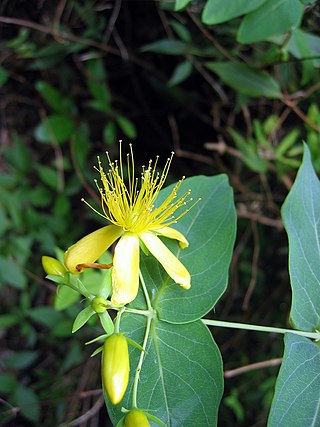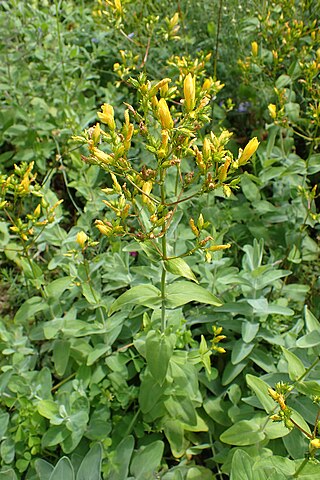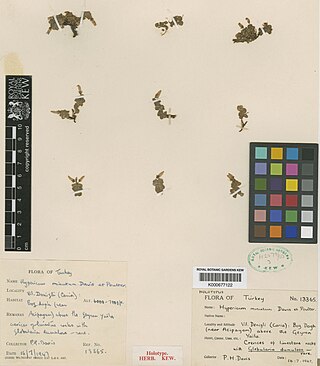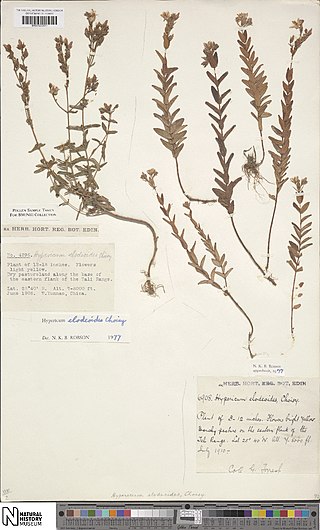
Hypericum is a genus of flowering plants in the family Hypericaceae. The genus has a nearly worldwide distribution, missing only from tropical lowlands, deserts and polar regions. Many Hypericum species are regarded as invasive species and noxious weeds. All members of the genus may be referred to as St. John's wort, and some are known as goatweed. The white or pink flowered marsh St. John's worts of North America and eastern Asia are generally accepted as belonging to the separate genus TriadenumRaf.

Hypericum androsaemum, the shrubby St. John's wort, is a flowering plant in the family Hypericaceae. Commonly called tutsan or sweet-amber, the species is cultivated as an ornamental plant because of its striking red-tinted foliage, bright yellow petals, and its large clusters of fruit. Cultivars like 'Albury Purple' and 'Golden Tutsan' which have leaves with more pronounced purple and golden coloring, respectively.

Hypericum grandifolium, the large-leaved St John's wort, is a species of flowering plant in the family Hypericaceae. The plant is a bushy shrub that can grow to almost 2 meters tall. It has large leaves, golden yellow petals, and seed capsules that split open. H. grandifolium is native to the Canary Islands and Madeira in Macaronesia, but has become invasive in other regions, including California, after escaping from cultivation as an ornamental plant. It is parasitized by wasps and fungi, and is capable of reproducing through its rhizomes.

Hypericum annulatum is a species of flowering plant in the family Hypericaceae. It is a perennial herb of varying heights which grows upright, with more than a hundred flowers of a golden yellow color. First described in 1827, the species has a wide distribution from Eastern Europe to East Africa, and its appearance can vary greatly based on its geographic location. It has been used in Bulgarian folk medicine, and has more recently been investigated for its effectiveness in slowing the growth of or killing certain types of human cancer.

Hypericum bupleuroides is a species of perennial flowering plant in the St John's wort family, Hypericaceae. It grows 45–80 centimeters tall, and notably has perfoliate leaves that are fused at the stem. It has pyramid-shaped flower clusters of 1 to 25 flowers with yellow petals in a star-shaped arrangement. The species is found along the Black Sea coast near the Turkish–Georgian border. Hypericum bupleuroides has a small distribution and specific habitat requirements that make it vulnerable to environmental pressures.

Hypericum foliosum, the shining St John's wort, is a species of flowering plant in the family Hypericaceae. It is a bushy shrub endemic to the Portuguese Azores Islands with golden yellow petals and many stems. The species was described by William Aiton in 1789 and was later placed into section Androsaemum of the genus Hypericum by Norman Robson in 1984. It has a diverse essential oil profile made up mostly of monoterpene hydrocarbons, and significant concentrations of various medicinally useful phenols and carotenoids. Populations of the plant are small in number, but quick to colonize cleared areas like groves, landslide areas, and volcanic ash deposits. It is parasitized by fungus and by moth species, but is not considered endangered by the IUCN. H. foliosum is used in traditional medicine on the Azores for diuretic, hepatoprotective, and antihypertensive purposes. It also has in vitro antibiotic and antioxidizing capabilities.
Hypericum cuisinii is a perennial herb in the genus Hypericum, in the section Adenosepalum. The herb has pale yellow flowers and occurs in Greece and Turkey.

Hypericum undulatum, the wavy St Johns Wort, is a herbaceous perennial flowering plant native to western Europe and northern Africa. The specific name undulatum is Latin, meaning "wavy" or "undulated", referring, just as the common name, to the wavy leaf margins of the herb. The plant has a diploid number of 16 or 32.

Hypericum sect. Adenosepalum is one of 36 sections in the genus Hypericum. Its type species is Hypericum montanum.

Hypericum sechmenii, or Seçmen's St John's wort, is a rare species of flowering plant of the St John's wort family (Hypericaceae) that is found in the Eskişehir Province of central Turkey. It was first described in 2009 by Turkish botanists Atila Ocak and Onur Koyuncu, who named the species in honor of Özcan Seçmen, a fellow botanist. They assigned the species to the genus Hypericum, and Norman Robson later placed H. sechmenii into the section Adenosepalum.

Hypericum formosissimum is a species of flowering plant in the St John's wort family Hypericaceae. Found in the cracks of limestone rocks, it is a small perennial herb that grows in a pillow-like shape, has yellow flower petals, and blooms in the late summer. The plant is rare and has a limited habitat in Turkey, Armenia, and Azerbaijan. It is threatened by rock collapses, urbanization, and road construction; it is not protected by conservation efforts.

Hypericum huber-morathii is a species of flowering plant in the St John's wort family Hypericaceae. It is a small perennial herb with few stems. It has narrow and brittle stems, thick leaves, flowers in clusters of varying numbers, small yellow petals, around twenty stamens, and three styles. H. huber-morathii is closely related to H. minutum and H. sechmenii, and also shares characteristics with H. lanuginosum. The plant is endemic to Turkey, and is found among limestone rocks in a limited region of southwestern Anatolia. Originally excluded from a comprehensive monograph of Hypericum, the species' placement within the genus is unclear. It has been placed in both section Adenosepalum and section Origanifolium.

Hypericum minutum is a species of flowering plant in the St John's wort family Hypericaceae. It is a small perennial herb that grows in tufts. It has slender and brittle stems, flowers in clusters of one to three, yellow petals with black and amber glands, few stamens, and a seed capsule with narrow grooves. H. minutum is closely related to H. huber-morathii and H. sechmenii and resembles a smaller form of the latter plant. The plant is endemic to Turkey, and is found among limestone rocks in a limited region of southwestern Anatolia. Originally excluded from a comprehensive monograph of Hypericum, the species' placement within the genus is unclear. It has been placed in both section Adenosepalum and section Origanifolium.

Hypericum coadunatum is a species of flowering plant of the St. John's wort family (Hypericaceae) that is found in the Canary Islands.
Hypericum psilophytum is a species of flowering plant of the St. John's wort family (Hypericaceae) that is found in Morocco and Algeria.

Hypericum tomentosum is a species of flowering plant of the St. John's wort family (Hypericaceae) that is found in the western Mediterranean.

Hypericum elodeoides, commonly called the Himalayan St. John's Wort, is a species of flowering plant of the St. John's wort family (Hypericaceae).

Hypericum orientale, the Ptarmic-leafed St. John's wort or Eastern St. John's wort, is a flowering plant in the family Hypericaceae. It is distributed across northern Turkey, Georgia, the Caucasus, and Dagestan. The species can be found on stony sloped amidst volcanic rocks in the mountains and in light woodlands at elevations of up to 2,300 m (7,500 ft). It flowers from May to June and July to August. The plant has small, bright yellow flowers and grows across the ground in a creeping pattern. It prefers full sun and is ideal for rock gardens, and is hardy down to -30°F.
Hypericum iwatelittorale, originally styled Hypericum iwate-littorale, is a species of flowering plant in the family Hypericaceae. Named for its habitat in the coastal regions of the Iwate Prefecture in Japan, little is known about the ecology and conservation status of the plant. The species is a small perennial herb with five bright yellow petals on its up to thirty flowers. It has many stamens, and an array of pale and black glands on its leaves, sepals, and petals. Described in 1937 by Hideo Koidzumi, it has at times been considered a synonym of Hypericum pseudopetiolatum. However, it was affirmed to be a valid species in 2003 and was placed into the type section of Hypericum, with its similarities to H. tosaense being noted.

















